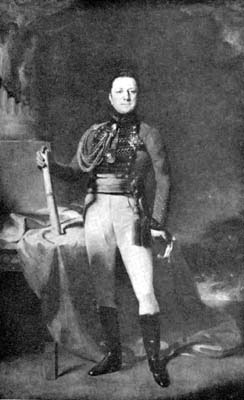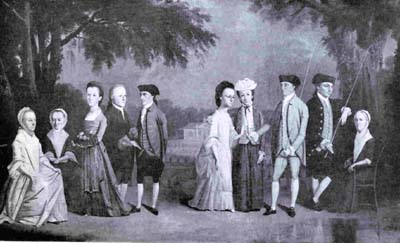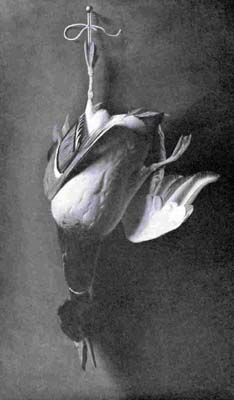
Bulletin 1 (I:1) May 1963
Home
Français
Introduction
History
Annual Index
Author &
Subject
Credits
Contact



![]()
A
Review of Accessions since
the Catalogues of 1957 and 1959
European and American Painting and Sculpture
by R. H. Hubbard, Chief Curator
Pages 1
| 2 | 3
The Scottish painter Sir Henry Raeburn (1756-1823) came at the
end of the great period of British painting in the eighteenth
century. In spite of temptations to practise in London he remained
in Edinburgh and became the leading Scottish portrait painter. A
recent purchase by the National Gallery (1962), the portrait of
Jacobina Copland, (12) illustrates the dazzling virtuosity of his
brushstroke and his brilliant handling of colour to perfection. The
picture was probably painted in 1794 at the time of the lady's first
marriage, to John Ronaldson of Blairhall. Her mother was a member of
the Dunbar family who trace their ancestry back to Crinan, the
hereditary abbot of Dunkelf, whose son was murdered by Macbeth in
1040. It has been shown in two important Raeburn exhibitions (13)
and was on extended loan at the National Gallery of Scotland,
Edinburgh, from 1950 to 1962.
The work of Raeburn's successor in Edinburgh, Sir John Watson Gordon
(1788-1864) was carried out in the first half of the nineteenth
century. Since 1948 he has been represented in the National Gallery
by a half-length of the Edinburgh lapidary John Sanderson, the gift
of the sitter's descendants in Vancouver. In 1958 the Gallery added
the full-length portrait of the 9th Earl of Dalhousie,
governor-general of Canada from 1819 to 1828. It is intended to form
part of a future national portrait gallery.
A group of pictures presented by Mrs H. A. Bulwer of Vancouver
has filled one of the larger gaps in the Gallery's representation of
English painting of the early nineteenth century, especially the
Norwich School. These include landscapes by John Sell Cotman
(1782-1842) and his son Miles Cotman (1810-1858) and portraits of
members of the Bulwer family by Joseph Clover (1779-1853) and
Frederick Sandys (1832-1904), the latter a friend of Dante Gabriel
Rossetti.
American colonial painting was naturally dependent upon the English
school. The first example to enter the National Gallery of Canada
was The Tannatt Family, painted about 1775 by Henry Benbridge
(1743-1811/2). Born in Philadelphia, Benbridge visited Italy in 1764
and is said to have been a pupil of Mengs and Pompeo Battoni, though
the proportions of his figures and their caricatured faces indicate
some contact with Thomas Patch. After 1771 he worked in Charleston,
South Carolina. During the American Revolution he is said to have
been a prisoner of the British. The people in this picture were
mostly of the opposite camp, being merchants and colonial officials
of Savannah, Georgia. The portrait was brought to Quebec by one of
the ladies in the picture, who married Thomson, the Commissary
General of Canada; it was given to the Gallery in 1960 by a
descendant, Mr Jasper Nicolls of Ottawa. An outdoor conversation
piece in the English manner, it is full of interesting details of
costume, landscape, and architecture.
From the American school of the early nineteenth century come two
other works, an anonymous portrait of 1823, The Perras Children,
painted in St Louis and attributed to François-Marie Guyol de
Guiran; and a large Still Life attributed to Severin Roesen (c.
1871), a German-born painter active in New York and
Pennsylvania.
To the foregoing have been added several examples of late
nineteenth- and early twentieth-century American painting. Before
the purchase of Mallard Drake Hanging (14) by William Harnett
(1848-1892) the Gallery had nothing from this period when American
painting most greatly influenced Canada. This picture, signed and
dated Munich 1883, is a fine and typical work by the Irish-born
Philadelphia painter whose style was formed by contact with the
Dutch and German schools. It illustrates the extraordinary technique
he developed in the painting of still life in a trompe-l'oeil
manner. Of the same period but by a very different artist comes the
small Landscape by Ralph Blakelock (1847-1919), the New York recluse
who painted in a dark, poetic style.
From the early twentieth century comes the well known portrait by
Robert Henri (1865-1929) of his friend and fellow artist George Luks. (15)
It was painted in 1904, when the New York group known as The Eight
were rebelling against borrowed Europeanisms and beginning their own
native movement. Prior to the purchase of this picture in 1961 The
Eight (nicknamed the Ashcan School) were represented in the Gallery
only by the work of their two Canadian-born and least typical
members, Maurice Prendergast and Ernest Lawson.
Turning back to Europe, the Gallery has acquired its first example
of classicist painting in France. Lacking funds to buy works by
David and Ingres, it has filled the gap very modestly by a portrait
of a Young Woman by Louis-Léopold Boilly (1761-1845), the 'little
master of the Revolution'. This exquisite small picture illustrates
the remarkable luminosity of his style, which he achieved partly
through experiments with varnishes.
The collection of British painting, the one modern field outside the
Canadian in which acquisitions have been made consistently by
purchase and gift since 1913, has been enhanced by the addition of
works of various contemporary painters including William Crozier (Fall,
a gift from the Contemporary Arts Society, London). Edward
Middleditch (Cactus Flowers, another gift from the C. A. S., and
Reflections, Evening, a purchase), and William Townsend (Lake
Kalamalka) among others. (16)
The representation of European modern sculpture, a relatively new
field of collecting for the National Gallery, has had two additions,
in the form of the work of two of the great modern sculptors. The
Bust of Anatole France by Antoine Bourdelle (1861-1929), famous for
his reliefs at the Theatre des Champs-Elysées in Paris and the great
Vierge d'Alsace, is a well known bronze of 1919. Also purchased was
a bronze Horse by the contemporary Italian sculptor Marino Marini.
Their Excellencies The Governor-General and Madame Vanier have made
the generous gift of three fragments from Sir Jacob Epstein's first
great commission, the 'Strand statues' on the outside of the British
Medical Building in the Strand, London. The projecting parts of the
figures were removed after the building had been taken over by the
Rhodesian government, presumably because the weather had eroded
them, and these fragments were acquired by General Vanier when he
was at Canada House, London, in the thirties. They have been
installed at Government House, Ottawa, for the duration of Their
Excellencies' régime.
Annual Index | Author & Subject | Credits | Contact
This digital collection was produced
under contract to Canada's Digital Collections program, Industry Canada.
"Digital
Collections Program, Copyright
© National Gallery of Canada 2001"